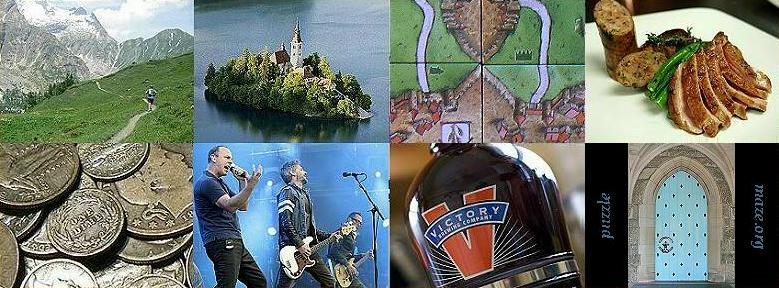
PuzzleMaze - Brazil & Urugay
 |
Getting there from PHL was three hops, Miami, Sao Paulo, Porto Alegre by air, then a 500K drive. The drive took about 5 hours, which wasn't too bad. Alternatives would have been 3 hops thru Montevideo, and about the same length drive. Certainly wasn't a particularly easy place to get to for only a weekend of racing, but I was curious to see what the O scene was like in South America, and this seemed like the best chance I would possibly have for a while.
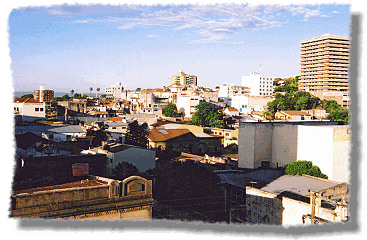 |
The drive, and the races, were in a part of South America known as the pampas, sort of hilly, gaucho (cowboy) country. I was trying to think of what other areas it reminded me of -- it was sort of like parts of Texas or some lower Front Range areas (tho wetter), and Latvia (tho hillier), but those are imperfect matches. I was driving along and didn't see to many trees, and no parks, and was wondering where races could be held. In fact, I only drove thru a total of amount 500m of forest the whole drive out there. I got the sense, tho, that there was enough moisture that the area would all be thickly forested (temperate, not jungle or rain forest) if the hand of man were not present.
One thing you don't immediately think of when going to South America for O is your compass. Competition compasses made for the Northern Hemisphere don't work south of the Equator. Apparently, there are compasses balanced specifically for South America, but I didn't have one of these. I did have one specifically balanced for Australia (or so it was claimed), so I packed that and hoped for the best.
The language in Brazil is Brazilian Portuguese, and Latin American Spanish in Uruguay. In the border town I was told they spoke a dialect called Portenol, which, fortunately, was close enough to Spanish for me, as I was getting nowhere with the Brazilian Portuguese pronunciations. Virtually no one on the street spoke English, tho I was lucky enough that some of the organizers did.
 |
The model was on the Brazil side, about a 15 minute ride from town (at the Parque de Eventos Jose Rufino de Aguiar). My ride was "J. F.", one of the course setters for the long distance race. I asked him who made the map, if they had European mappers; he replied "my friend made it". He kept warning me about the vegetation -- "be careful, you will get lost". He told me the point of the model was to see how the vegetation was mapped. That pretty much became the theme of South American mapping and course setting to me -- it seemed to be all about the vegetation and vegetation features -- not much mention (or use) of contour features.
I was more interested in the overall quality of the map, whether features other than veg would be useful, and whether or not my Australian compass would work. I realised right away that I had no known good points of reference to test the compass (I mean, I didn't know if the map were true), but I did notice that the compass settled quickly, and seemed to work normally. I also noticed point features didn't line up all that well, but at least the compass got me pretty much in the general direction.
 |
I noticed that none of the controls were on contour features. I also noticed that all of the controls were "yellow to orange" level, in US parlance [M14-M16 level]. I noticed that veg features were common choices for control points, and expected the real races would be like this also -- yellow course orienteering with veg features and no real use of contour features (I turned out to be somewhat right). I did go into the green a bit, and it was somewhat passable, the problem was the contour mapping just didn't make sense, and non-contour features were placed wrong with respect to the local contour features. For example, I found clearings mapped as being in reentrants as actually being on the spur, and the fence junction (#40), was on the other slope of a drainage than what is shown.
Moreover, the vis in the green was extremely poor, I made a note to not go thru the green under any circumstances, unless I had a good handrail that would contain the control or connect to another such handrail, or a catching feature along those lines (contour independent line features). I noticed the fences all seemed to be relatively correct, except for the unmapped ones. I didn't expect any controls to be placed in the green, as I did not feel that could be done fairly (I turned out to be wrong about this).
 |
Later, I tried to find out more about the mapping for all the races. I never was able to find out where the base maps came from. I heard a rumor (unconfirmed) that GPS was used in the field checking (if true, a dubious proposition given some of the thick canopy in play). I was told they had "difficulty drawing hills", and was asked if I had any expertise in that area (not being a mapper, no). Their plan going forward seemed to be to use satellite photos available on the Internet for future mapmaking (and they asked if I had experience with this - again no), I suggested aerial photos and European base mappers; I got the impression that this was out of their budget. (The races were cheap: USD 7 for 3 races and a model; they specifically stated a goal of keeping entry fees extremely cheap so the sport was available to everyone (they also declined e-punching for budgetary reasons)).
There were only about 15 people at the model, about 5 Argentineans, 5 Brazilians, and a handful of Europeans. I suspected that model events weren't part of the local race preparation culture, or more likely, people had to work and just couldn't take off for a model event like we do.
 |
The relay was what I would call a "sprint relay" (but WT more around 22 per leg) -- it was a real common sense format, something I'd like to see more of in the US, rather than the class/different course system we use now. Simply 3 loops, all about 2.5K, forked, with each team running the loops
 |
I ran an ok, but not great race. I had trouble with punching -- there were two controls at each point, and the second one had a different code than the code you were looking for. Moreover, the real code on the other control was taped over, so you had to look really hard at it, so it took a bit of time verifying your code. Finally, the locals hadn't gotten accustomed to punching quickly, so long queues formed. I did lose alot of time punching, and also made a pair of small booms, probably losing 3 minutes overall on the short course. I was at #9 when I heard the first cheering, so I figure I was that far back. I also had the longest loop by about 200m, so that is worth some time, so I'm not sure I would have been close to winning my leg even with a perfect race (estimates ranged from me being 2-5 minutes back -- I never saw any results of any kind). I ran 9 min/k; it was hot, about 35 degrees.
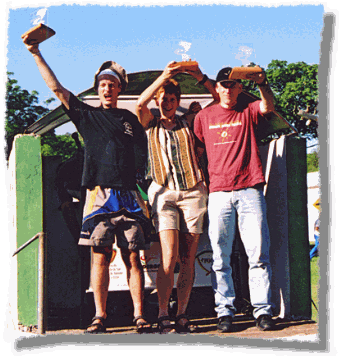 |
Our other runners had good races (tho Paul lost his card, and 2 minutes looking for it), and he crossed the finish line in 5th place. We has a mixed team, but were listed in Men's open, not being sure of the classes ahead of us, I wasn't sure if we medalled or not, and only learned that we were third in class when our team number was announced (in Portuguese -- we all looked at each other -- is that us?) at the awards ceremony. We were first mixed, tho.
There were about 50 teams total, I was happy to walk away with hardware for a not so great race; perhaps I left one place in the forest, not more.
[Full map and routes here]
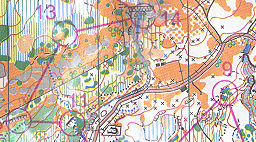 |
The answer is not particularly well. While there was certainly an element of home field advantage (being accustomed to running fast in the heat and the maps), and an element of bingo, it was clear that the top people here are much better than me, at least with this style of course setting and terrain.
 |
The middle was about 5K, and the first part was quite simple; I blew thru it somewhere in the sixes (unfortunately, my splits are lost), despite the fact that #7 was hung on the wrong feature. Heading for number #9, tho, I started looking for the old ladies, because that seemed to be the only thing missing from the bingo parlour. There was this huge trail along the way to #9, which I could not seem to locate on my map, but I did see a steep hillside with nasty veg, so I figured my control was up there somewhere. I followed an unmapped trail up the hill towards the sound and sight of thrashing, and found something orange. We'll count it as a spike.
Following the trail along the ridge to #10 seemed reasonable (there wasn't the same concept of trail grading as in the US -- that thing was a mowed turnpike), but again I could not solve the way to force success on this one. I was not so lucky as with #9, and lost about a minute conducting a search thru some nastyish veg. Turns out, IMHO, the feature was farther from the trail, in a different spot relative to the the contours, and the feature was hard to see among the supporting debris. Bag was also hung on the wrong side of the feature based on its description.
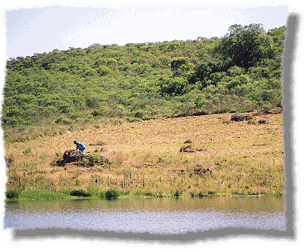 |
#11 they didn't describe which cliff of 2 in the circle; seemed logical to follow the stream to the closest one, but the stream forked along the way. I got lucky taking the correct fork, then figured to head to the second cliff when it wasn't on the first one. 2-1 so far. I was finding the map difficult to read, I think due to the printing and the amount of detail.
#12 they didn't say where on the cliff, but I correctly surmised the middle of it. #13 was where I lost the most time, clearing somewhere in flat, nasty, veg. I claimed bingo due to the number of unmapped clearings in there, tho in retrospect, I feel the three minutes lost were more my fault, as success could have been forced with a careful appreciation of the contour picture going in. Problem is, I didn't really trust it (it didn't seem right), but it goes back to the point I once made of having to assume there is a way to force success, as you are no worse off if you were wrong. I was also bonking, as hard as that is to believe on such a short course, but the heat and lack of water stop anywhere will take its toll (I generally prefer heat, but hadn't trained in it in a long time, and prefer water with my heat).
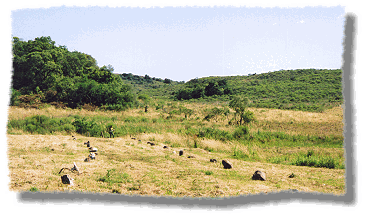 |
The rest of my progress was hampered somewhat by a really nasty thorn that lodged in my shoe. It took about 15 minutes after the race to get it out. I was able to run after some adjustments, and navigationally I was fine (tho slower -- bonking and thorn) for the rest of the race, despite a small wobble on the somewhat bingoish looking #17.
My time was 51:10, tho they listed me at 55:28. The listed WT was 40:24. If all the times are off by 4:18 (as someone stated), that would indicate a WT of around 36 minutes, putting me over 40% behind the Brazilian winner (all H21E runners were listed as Brazilian, except myself). If we take out my 4 minutes of problems, I'm 30% behind the winner with a perfect race (tho in heat, non-technical terrain). This compares to being about 46% behind Carsten Jorgensen and Thierry Gueorgiou at the Middle Qual at WC (tho with mistakes). I don't know if one can use this limited data to guess where the top Brazilians are relative to the world's best or not. I heard that some top Brazilians would be going to Europe next year, so hopefully we'll see.
Despite my problems with the map, and perhaps some different ideas I had in terms of course setting, this was an enjoyable course, and seemed "mostly fair enough", as local conditions go, to determine a champion.
 |
I was told the "long course, H21E" was only 6K, and this turned out to be true. I figure you ought to be able to do anything in 10min/k, and a time of 60 shouldn't look too bad. I was once again warned about the vegetation.
I moved thru the first 6 controls without too much trouble, grumbling that #4 was a bit bingoish, and placing the water symbol right on the attack to #6 probably wasn't up to international standards (I navigated to the water symbol, then could not really read what I was doing). I did the first 6 in about 18 minutes, not too bad considering the steepness and the horrible weather (getting thru even the easy looking terrain wasn't as easy as it looks). This put me right on a 10 minute pace.
Then it only took 49 minutes to find #7. The green was looking pretty nasty, so I decided to climb all the way up the hill along the fence, along my game plan of always use strong handrails. I couldn't find the fence junction at first. Eventually I found it, and then that trail (which was dubious, little more than a deer trail in the green), which I followed until it split, contrary to the map. The fork I took petered out, and I could not re-find the junction. The green was brutal, especially in the downpour. It wasn't thorny tho -- the only thorny plants were cacti and wait-a-minute vines. I figured to contour over and have a small chance of finding one of the ditch features, the trail, or the bigger reentrant. Eventually I found the clearing to the southwest after not finding any of the above. Verified the shape. No trail leading out to the northeast as mapped, so I went thru the jungle on compass, up all those lines. Hit a ditch, ok, followed it to a rootstock with a flag, ok, I know where I am again. Down the ditch to the boulder, over to the spring -- no spring, no trickle, no flag, no trail, eventually back to the clearing.
 |
Try again, this time I climb 20 lines all the way up to the cliffs where the number 8 is printed. Back to the rootstock, as and attack as carefully as one can under the circumstances. I realise it is tough to keep a bearing thru jungle on a dubious map when you are unsure of your compass, but how can one force success. When I missed a second time, I figured perhaps that rootstock was wrong.
So I decide to verify that. All the way back to the fence junction north of #6, then all the way up to the other fence junction northeast of the rootstock. Careful attack of the rootstock and I can't hit it. Someone points and locates it for me. Now in field checking mode. Walk to the boulder. Ok. Walk to the spring. No spring, again no ditch. Ok, I'm not going crazy. I must have climbed 100 lines by now. I'm thinking "what would Eddie do"? I often think this during races, and it helps. The only thing I know is that I am going to finish this course, and for it to count, I have to do it in three hours. I figure every control isn't going to be like this.
So I just wander around the dark green hoping to find something useful, and eventually I do: a runner in a Uruguayan uniform who points, unsolicited, and says diez metres. I figured it was off by 500m from where it was mapped, based on my troubles with #8 following, but a miss is as good as a mile out here.
So at this point, I decide I'll be happy to simply complete the 6K course in three hours.
Even tho I didn't know where I was, #8 looked easy enough. Just slog up the hill thru the green and collect on the veg boundary. I could find no features in route, tho I expected to find some of the stuff I found when looking for #7, and when I got up there, I did find the veg boundary, but the "green slash" was 4m tall, and just as thick, just a different species of green than was on the hillside, so that was no help. Moreover, I could not find the fence, and found myself looking at a steep downhill on the other side. I had absolutely no clue where I was (and it turns out I wasn't going crazy, the same experience was reported by the winner of D21E). I had to go all the way back to the fence junction between #6 and #7, thru the green, then follow the fence. Only a 22 minute split this time.
#9 was a lone tree in the jungle. 25cm diameter. Not sure how this got mapped among the other trees, much less became a control feature. Did spike it by blind luck, tho. En route from #8 to #9, still could not figure where I was on that first attack to #8.
#10 was a spike, but a 7:39 split for 130m. Talk about a treacherous hillside. There was also an unmapped canyon here -- it went the whole side of the hill up to down and was at least 3 lines deep. I imagine this is the feature represented by the dry ditch.
So I'm thinking things couldn't get much worse, now that I was off that hillside, and I should complete the 3 hour tour with no problems. Then I notice water has gotten into the map case, and pretty much the whole rest of the course is being obliterated (as I read my competition map now, the only printing left is numbers 5,6,7,8, and 20). So I memorize what is left of the course as best I can, and notice the overprint is bleeding into the back of the paper.
 |
I navigate the rest of the course like this, using memory and the bleed from the back of the map to figure where the course went, and the control descriptions to figure what feature. The terrain and weather really aren't much less brutal, and needless to say, the splits didn't get much better. Some things that should just seem easy end up being off by 10m, and in poor vis/mob, that adds up to minutes here and there. The only thing of real note in the rest of the course is that there were alot of unmapped rocky hills around #18, and I'm pretty certain #19 was mishung/mismapped pretty badly (14 min for 100m; and on paper, this is hardly a difficult control, even with the printing gone).
At about #20, I look at my watch, don't think I have enough time to make it, then realise I started my watch 2 minutes early (so I could track my time o do all the pre-race machinations, which were attach the control descriptions, paper punch card, and study the map, all in the downpour).
I cross the finish line with a time of 2:59:07, just barely making it, and I'm quite happy with that result.
I'm told the WT was 80 min, but people I talked to DNFed. I do see a handwritten note in Portuguese with the first lines reading "proteste H21E no #95 [control 7]", and as the H21E results for day 2 were conspicuously left off the final results, I speculate that the protest was upheld, but I could not stick around at the time to see for sure. I think its not so much that it was mishung, but perhaps just mismapped so completely that it was impossible to force success. Someone told me they thought it was 50m off and 2 lines down, whatever that means in the context. But there were so many other problems that it probably could have been thrown out if #7 where fine.
Well, this becomes the hardest course I've ever completed. I think it was good rogaining or extreme O training.
Still, all and all, a good trip. Got to spend alot of time with the locals, and talk O, despite language problems. Everyone I met was super friendly. I don't think they are blessed with the best terrain, but they are enthusiastic about orienteering, and I think they have some really good people.
I tried to get a feel of how widespread orienteering is in South America. I was told there was some activity in Columbia, Chile, and Ecuador, but that almost all the activity was in Brazil and Uruguay. Argentina has a few maps but no clubs, and about 100 orienteers, some of which made the trip, one of which who has also run in PWT and O-Ringen. Argentina seems really intent on building their program up, and on developing equestrian O.
There were about 240 runners, mostly Brazilian, with URU and ARG the only other South American countries represented.
I tried to find out how big the scene was in Brazil, I was told there were about 15-20 clubs just in the state the races were being held in (Rio Grande do Sol; Brazil has 25 states, and as a country, is a bit larger than the US lower 48). I got the impression that the level of activity was on the same order of magnitude as in the US, but certainly not more.
Well, despite my long distance race problems, it was worth going. I'll go back, but I'm really interested in going back in 10 years and seeing where the O scene is.